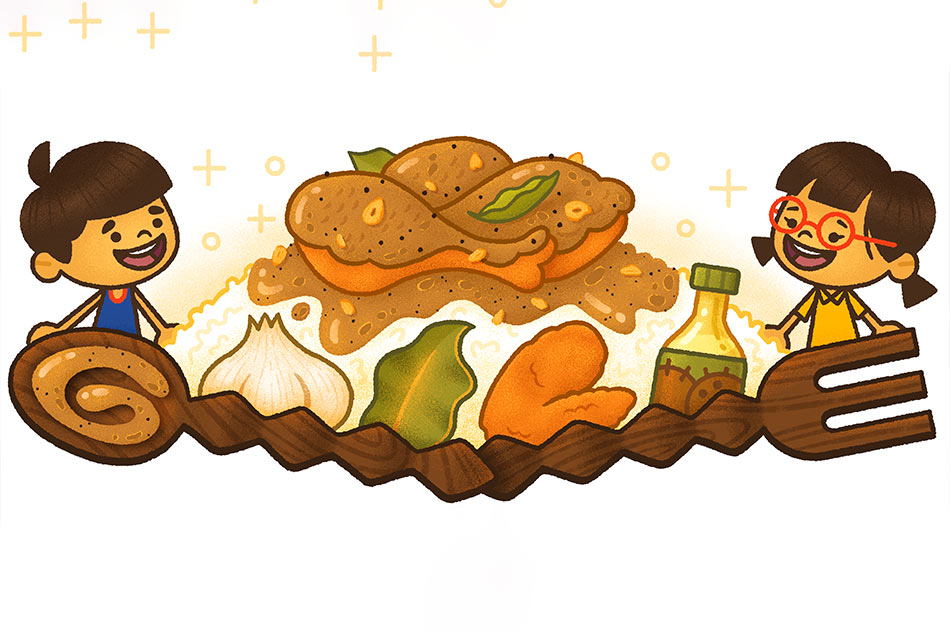Why adobo is the first Google Doodle Filipino dish
ADVERTISEMENT

Welcome, Kapamilya! We use cookies to improve your browsing experience. Continuing to use this site means you agree to our use of cookies. Tell me more!
Why adobo is the first Google Doodle Filipino dish
ABS-CBN News
Published Mar 15, 2023 07:33 PM PHT
MANILA – A staple in Filipino cuisine, the adobo was unveiled as the first Filipino dish to be featured in the Google search bar on Wednesday.
MANILA – A staple in Filipino cuisine, the adobo was unveiled as the first Filipino dish to be featured in the Google search bar on Wednesday.
"Adobo is an important part of the story of Filipinos. It is an evolving, well-loved comfort food or way of cooking that crosses all economic boundaries. For adobo to be featured as a Google Doodle – the first Filipino dish at that – is a Pinoy pride moment!" Mervin Wenke, head of communications and public affairs at Google Philippines.
"Adobo is an important part of the story of Filipinos. It is an evolving, well-loved comfort food or way of cooking that crosses all economic boundaries. For adobo to be featured as a Google Doodle – the first Filipino dish at that – is a Pinoy pride moment!" Mervin Wenke, head of communications and public affairs at Google Philippines.
"It is an honor to launch this Doodle that celebrates the uniqueness and diversity of Filipino cuisine on such a global platform," he added.
"It is an honor to launch this Doodle that celebrates the uniqueness and diversity of Filipino cuisine on such a global platform," he added.
The word ‘adobo’ was first added to the Oxford English Dictionary (OED) in December 2006 and was included on the word list of the dictionary's next quarterly update released the year after.
The word ‘adobo’ was first added to the Oxford English Dictionary (OED) in December 2006 and was included on the word list of the dictionary's next quarterly update released the year after.
ADVERTISEMENT
While there are many variations to the dish, adobo has basic elements such as marinated meat or vegetables braised into a stew. Common ingredients include vinegar, soy sauce, garlic, bay leaves, and black pepper.
While there are many variations to the dish, adobo has basic elements such as marinated meat or vegetables braised into a stew. Common ingredients include vinegar, soy sauce, garlic, bay leaves, and black pepper.
Several areas within the Philippines give their adobo a regional twist. For instance, in Visayas, they enjoy adobong puti (white adobo), considered by some to be the original indigenous style, which exclusively uses vinegar without any soy sauce.
Several areas within the Philippines give their adobo a regional twist. For instance, in Visayas, they enjoy adobong puti (white adobo), considered by some to be the original indigenous style, which exclusively uses vinegar without any soy sauce.
In places like Southern Luzon, where coconut milk is a food staple, creamier adobo recipes like adobong manok sa gata (chicken adobo with coconut milk) are extremely popular.
In places like Southern Luzon, where coconut milk is a food staple, creamier adobo recipes like adobong manok sa gata (chicken adobo with coconut milk) are extremely popular.
Others substitute meat with seafood like squid, or locally available vegetables like kangkong (water spinach) or sitaw (string beans).
Others substitute meat with seafood like squid, or locally available vegetables like kangkong (water spinach) or sitaw (string beans).
"Adobo is a source of Filipino pride and identity. The mere mention of the word 'adobo' to Filipinos wherever they are in the world will easily get them craving for the taste of home. Whether it's eaten with rice, pandesal or just on its own, there is nothing like our very own adobo," said renowned restaurateur and food writer Claude Tayag.
"Adobo is a source of Filipino pride and identity. The mere mention of the word 'adobo' to Filipinos wherever they are in the world will easily get them craving for the taste of home. Whether it's eaten with rice, pandesal or just on its own, there is nothing like our very own adobo," said renowned restaurateur and food writer Claude Tayag.
"Celebrating adobo as the very first Filipino food Google Doodle is truly commendable. This is a great way to create meaningful conversations online about our rich and diverse food heritage."
"Celebrating adobo as the very first Filipino food Google Doodle is truly commendable. This is a great way to create meaningful conversations online about our rich and diverse food heritage."
RELATED VIDEO:
ADVERTISEMENT
ADVERTISEMENT



